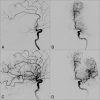Anterior Circulation Acute Ischemic Stroke Associated with Atherosclerotic Lesions of the Cervical ICA: A Nosologic Entity Apart
- PMID: 29051203
- PMCID: PMC7963591
- DOI: 10.3174/ajnr.A5404
Anterior Circulation Acute Ischemic Stroke Associated with Atherosclerotic Lesions of the Cervical ICA: A Nosologic Entity Apart
Abstract
Background and purpose: Mechanical thrombectomy for patients with acute ischemic stroke with tandem occlusions has been shown to present varying reperfusion successes and clinical outcomes. However, the heterogeneity of tandem occlusion etiology has been strongly neglected in previous studies. We retrospectively investigated patients with acute ischemic stroke atherothrombotic tandem occlusion.
Materials and methods: All consecutive patients with acute ischemic stroke with atherothrombotic tandem occlusions treated with mechanical thrombectomy in our center between September 2009 and April 2015 were analyzed. They were compared with patients with acute ischemic stroke with dissection-related tandem occlusion and isolated intracranial occlusion treated during the same period. Comparative univariate and multivariate analyses were conducted, including demographic data, safety, and rates of successful recanalization and good clinical outcome.
Results: Despite comparable baseline severity of neurologic deficits and infarct core extension, patients with atherothrombotic tandem occlusions were older (P < .001), were more frequently smokers (P < .001), and had globally more cardiovascular risk factors (P < .001) than the other 2 groups of patients. The patients with atherothrombotic tandem occlusions had significantly longer procedural times (P < .001), lower recanalization rates (P = .004), and higher global burden of procedural complications (P < .001). In this group, procedural complications (OR = 0.15, P = .02) and the TICI 2b/3 reperfusion scores (OR = 17.76, P = .002) were independently predictive factors of favorable clinical outcome.
Conclusions: Our study suggests that atherothrombotic tandem occlusions represent a peculiar and different nosologic entity compared with dissection-related tandem occlusions. This challenging cause of acute ischemic stroke should be differentiated from other etiologies in patient management in future prospective studies.
© 2017 by American Journal of Neuroradiology.
Figures




References
MeSH terms
LinkOut - more resources
Full Text Sources
Other Literature Sources
Medical
Miscellaneous
